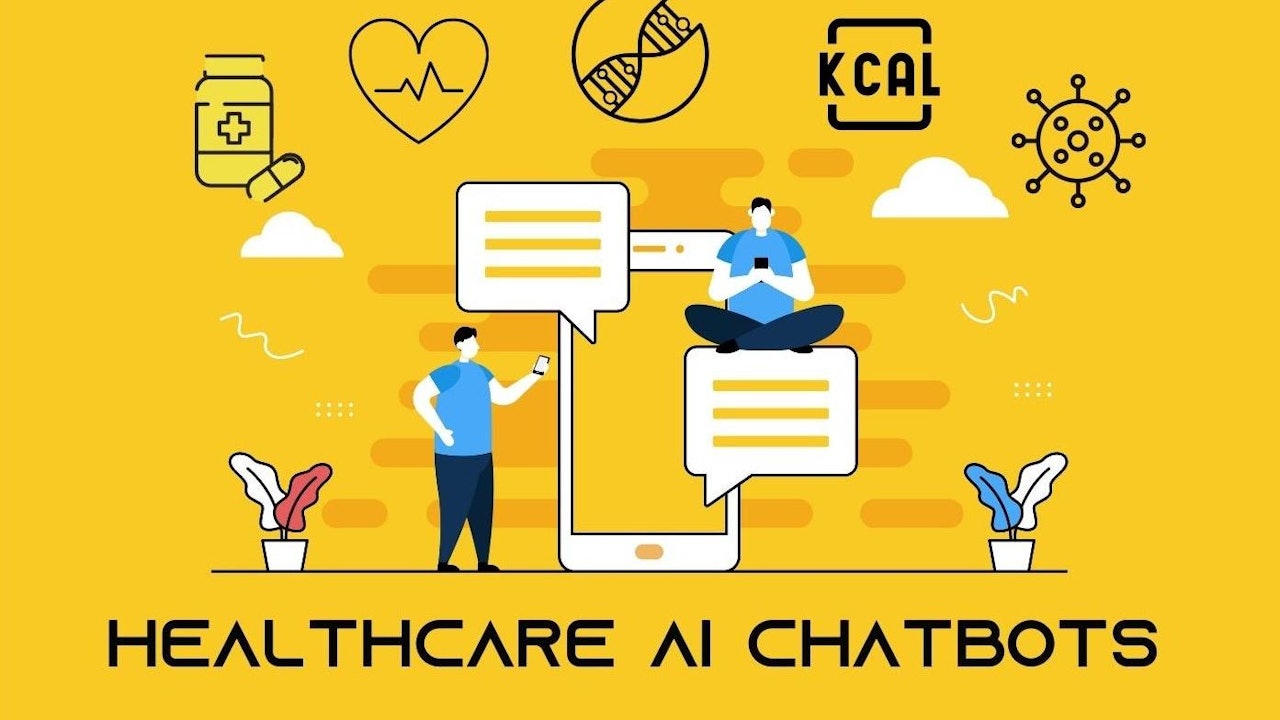Healthcare AI chatbots are becoming the first place to contact during any medical assistance. The market is about to grow from 226.2 Million (USD) to 1.6 Billion (USD) by 2025 at the CAGR of 33.7% and opening opportunities for Startups, SMEs, and Enterprises to go for Healthcare Chatbot Development.
By looking at the scarcity of healthcare workforce or the Physicians at the current scenario, it is clear that human beings are getting issues with primary care as well. To improve personal & primary care, and for removing the burden from our doctors & other healthcare workers, AI Chatbots could be a way to Damascus for the healthcare industry.
Chatbots are algorithm-based conversational engines that simulate human conversation using chat interface, or over voice commands. It can be used to handle queries and provide assistance to humans using artificial intelligence. Chatbots are very popular these days, and they are helping humans by working as a virtual assistant and providing most of the services that a human agent can provide.
AI & ML chatbots can be used in many instances, like for ordering groceries to book an appointment, for checking the weather to get the latest news, and yes! Also, for health observation & medical assistance. The healthcare industry is improving day by day, and to make it more advanced and remove the barriers like medical workforce & infrastructure scarcity, chatbots are providing endless possibilities.
That’s the reason for our Chatbot Developers to develop AI engine based healthcare chatbot solutions to make personal care easy for the potential people out there.
Why AI Chatbots are the Future of the Healthcare Industry?
 Florence, HealthTap, Your.Md, Ada, Forksy, and the recent one Clara, are some of our new health assistants to help us maintain a healthy lifestyle. These chatbots or virtual assistants are made of optimized algorithms that work on triage and provide basic wellness help on our fingertips without troubling the physicians. Most of the applications are working on the channels that if your triage badge is posing a severe color then you’ll be asked to meet a doctor or the app will book an appointment for you.
Florence, HealthTap, Your.Md, Ada, Forksy, and the recent one Clara, are some of our new health assistants to help us maintain a healthy lifestyle. These chatbots or virtual assistants are made of optimized algorithms that work on triage and provide basic wellness help on our fingertips without troubling the physicians. Most of the applications are working on the channels that if your triage badge is posing a severe color then you’ll be asked to meet a doctor or the app will book an appointment for you.
All the implications that AI chatbots are providing is removing the gaps from patient engagement and issue management. Chatbots can save patient’s or user’s health parameters. Based on these parameters, a report can be generated that could help to diagnose in many cases and also save the time of a doctor. It can also remind you of taking pills on time or tracking activities, diet, or upcoming doctor appointments.
Current Applications or Functions of the Available/Existing Chatbots:
- Response to simple medical questions with advice 24/7
- Integrate with wearable smart devices to measure health parameters
- Track patients’ health parameters to diagnose easily
- Medication management & recommendations about drugs
- Connect patients with physicians for diagnosis or treatment
- Suggestions for diet as per body weight, height, and other health parameters
Impact of AI Chatbots in Healthcare Industry:
Ai-chatbot There are several possible outcomes of virtual health assistants. From removing the burden of medical professionals to providing 24/7 medical support, chatbots are creating favorable conditions for both the users and medical workforce. Some primary changes that Chatbots are creating for better patient engagement and issue management are as follow:
Decreased number of patients in the waiting room Relieved medical workforce from the repetitive tasks Reduced cost, and improved outcomes & efficiency of the healthcare system Reduced demand of primary care physicians Predictive medical care & personalized medication Post-surgery follow-ups or to-do teller
 View Website
View Website
 View Website
View Website
 View Website
View Website
According to GMI (Global Market Insider), the health virtual assistant market is estimated to reach about 1.6 Billion (USD) at the CAGR of 33.7% by the start of 2025. Multiple SMEs, startups, pharma companies, and even medical institutes are working to provide a seamless virtual medical solution to eliminate the medical scarcity and grab the opportunity to create a huge user base.
The data clearly shows the success of healthcare AI chatbots and the interest of people towards its implication & usage. By looking at possible outcomes, applications, and future implications of healthcare chatbots, it is clear that the future of the healthcare industry is going to have a bright outlook.
Growth Promoter for Healthcare Chatbot Usage & Development:
The very common reason for the growth of healthcare chatbots is the services they provide. And also, the way these chatbots eliminate the gap between a person and medical help, can increase the adoption rate of such systems. There are multiple other reasons that could work as a growth driver for AI chatbot development & usage:
Less Waiting Time: Time that hospitals take to treat a disease Growing rate of smartphone users worldwide Increased usage of IoT enabled devices For reducing the treatment cost Scarcity of medical workforce Rising demand of self-service from customers
Possible Barriers in Growth of Healthcare Chatbot Development & Usage:
Every technology has got barriers that can affect its growth rate. Healthcare AI Chatbots have also got some physical and emotional barriers.
- Elder or older people can resist the use of new technology
- Clinical or medical decisions using an algorithm could create health risk
- Patients’ vital health information and other personal data could face security issues
- Lack of emotional connectivity between bot and user
- Unemployment on a large scale
- knowledge and trust issues in developing countries
Bottom Lines:
As the health industry is facing workforce shortage, it can be clearly seen that a chatbot can be an answer to this scarcity. These chatbots are a great way for primary care and users don’t need to be a burden on physicians for minor health concerns. Most of the healthcare chatbots work on the Triage process and it helps them to evaluate and categorize the concerns. In case of any critical issues, these healthcare AI chatbots ask the users to seek professional help or to book an appointment.
Maturity of the algorithms and used technologies during the chatbot development is also important from time to time. There should be a highly optimized & wise algorithm to prevent chatbots from failures, because it will assist real lives with medical queries.
So, by looking at the demand and scarcity of the medical workforce, it is clearly seen that the demand for personal health chatbots or assistants is growing day by day. The potential customers are waiting out there to get seen for their primary health concerns, so why don’t give them a cure using a chatbot! Build a healthcare chatbot using AI and ML
Some Common Frequently Asked Questions:
What is healthcare chatbot?
A healthcare AI chatbot is a virtual health assistant that works on an algorithm and provides answers in text or voice format for basic health queries. The main goal behind the healthcare chatbot is to provide primary care to the users, and also to remove the burden from healthcare workers. This also opens a huge opportunity for companies to provide services 24*7 to the current market demands.
Is healthcare chatbot safe?
Yes, chatbots are safe to use till some extent. They can help you to live a better life with some good and healthy recommendations. You can share your health parameters with them and based on these parameters, chatbots can help you diagnose or can help the medical professionals to eliminate the repetitive tasks. When it comes to safety of the user, chatbots work on AI, triage, and channeling. So, whenever there is a critical issue you’ll be asked to go for physician or professional help.
How healthcare chatbots are helping in Covid-19 pandemic?
Due to Covid-19 pandemic, the healthcare system is going out of enough medical professionals, the system is getting strained and creating hurdles for our primary care as well. According to WHO, there are just 9.2 million doctors and 18.1 million nurses worldwide, and the industry is getting short on the necessities like hospitals, workers, and other healthcare facilities.
But, what’s the solution to this scarcity and to our primary care because the pandemic has impacted badly on the healthcare system? Medical Chatbots with triage!
For helping people, the U.S. centres for disease control and prevention (CDC) and Microsoft Azure healthcare bot service have come up with a chatbot “Clara.” It works as an online self-checker for Coronavirus symptoms so that people in need can get access to the limited medical resources, and the system can cope with the crisis.
What are the objectives of healthcare chatbot?##
AI & ML based healthcare chatbots are commonly used for answering the medical or health queries of the users. They are also used for multiple other objectives like:
Removing overhead of primary care from medical professionals Reminding users for the medicines Diagnosing patients on the basis of health parameters For reducing the cost of disease treatment Relieving medical professionals from repetitive tasks





Comments (0)